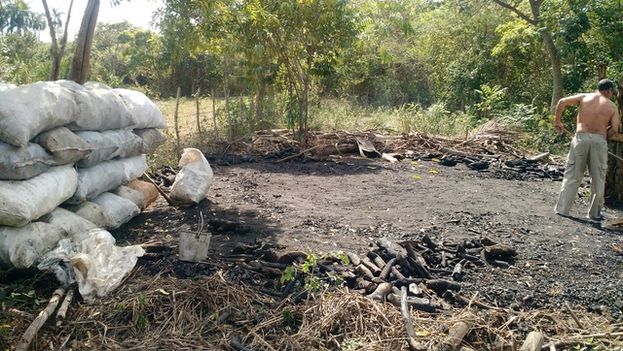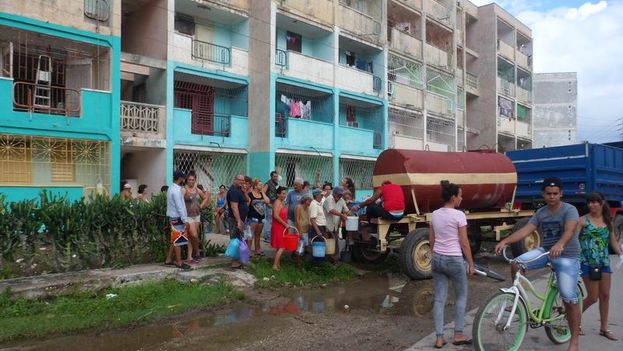
![]() 14ymedio, Luz Escobar and Zunilda Mata, Havana, 18 September 2017 — Black smoke from charcoal rises from an improvised fire in Dinora’s yard, which is close to the area most affected by Hurricane Irma in Caibarién, in the province of Villa Clara. In addition to half her house being on the ground, her new problem now is to cook without electricity or gas, in a place where local producers have increased the prices of this fuel, after energy shortages in the region caused by the hurricane.
14ymedio, Luz Escobar and Zunilda Mata, Havana, 18 September 2017 — Black smoke from charcoal rises from an improvised fire in Dinora’s yard, which is close to the area most affected by Hurricane Irma in Caibarién, in the province of Villa Clara. In addition to half her house being on the ground, her new problem now is to cook without electricity or gas, in a place where local producers have increased the prices of this fuel, after energy shortages in the region caused by the hurricane.
Two years ago, Dinora’s family was among the province’s 4,902 families who were able to buy an induction cooker, a lidded casserole, a jug, a frying pan and coffee pot for 500 Cuban pesos (CUP) on credit, which the state bank is assured of being repaid through deductions from wages and pensions.
“There has been no electricity for more than a week and I had to go back to cooking with charcoal,” she says via telephone.
The charcoal, made mainly from marabou, is managed primarily by state companies that pay the local producers – who have self-employment licenses that allow them to produce it – and then mostly export it. A small part of the production is left in the hands of the carboneros, for their own use and for private sales with prices governed by supply and demand. “While before Irma a sack of charcoal cost 25 CUP in Caibarién, now that same amount is now worth twelve times more.”
“A sack of charcoal can’t be found for less than 300 CUP,” Dinora explains to 14ymedio. “My monthly pension isn’t even that much, so when I run out of this, I do not know what I’m going to do,” says the retiree, adding that she plans to use the fallen branches and logs that Irma left in her yard to be able to boil water and prepare food.
The so-called Energy Revolution, promoted by the late Fidel Castro at the beginning of the 21st century, replaced the distribution of kerosene and alcohol in the rationed market, which had been used for cooking in rural areas, with electrical appliances, such as hot plates and electric water heaters. Consequently, the installation of gas conduits was shut down and citizens came to rely on these new devices, useless in cases when the electricity fails.
Now, after Irma’s damage to the power grid, smoke from charcoal fires fills hundreds of houses and yards in the central area, in the absence of any other cooking fuel. It is not a question of choice but of necessity. The less fortunate do not even have a few coals to ignite and must settle for eating cookies or canned food.
The residents in this coastal town are impatient at the slowness of the restoration of basic services, as they continue with the access roads cut off, electrical poles on the ground and more than 4,000 homes totally or partially collapsed. “It seems as if they have forgotten us,” Dinora complains.
Independent journalist Pedro Manuel González shares this feeling of abandonment and regrets that in the first days after the storm the brigades of linemen and trash collectors were transferred to the tourist areas. “Caibarién is forgotten and has no priority in the national emergency,” he said.

Just 72 hours after Hurricane Irma, the 14-mile causeway that connects the tourist area of Cayo Coco with the nearby province of Ciego de Avila was repaired. A priority that has bothered many residents in Caibarién.
Francisco Carralero, a resident of the Van Troi neighborhood, is annoyed by that priority and complains that in Caibarién “everything is going very slowly.” He treasures a tank that he managed to buy last June when the province began the sale of liquefied gas. He rented the cylinder for 400 CUP and refilled it for another 110. “Thanks to that, it has been possible to pour a little coffee in this block,” he says.
“Now a full tank can’t be had for less than 1,000 CUP and no one can even find one,” explains Carralero. “He who has gas is a privileged one, because most of the residents of this neighborhood have not been able to light their stoves for more than a week.”
“Heat” and “chill” are two verbs difficult to conjugate these days in the area. In the informal market blocks of ice taken from the state lobster company are sold at about 300 CUP each. “He who has money gets cold water and he who doesn’t has to deal with it,” adds Carralero.
The losses are not only in infrastructure but also in food and resources.
“Everything I had in the refrigerator was spoiled because I didn’t have time to consume it,” explains the Villaclareño. In his area only some buildings have recovered electrical service and, he protests, they still have not received “any type of free food supply.”
The town’s pizzeria sells a serving of spaghetti for 5 CUP, the same price they charged before the arrival of the hurricane. Several distribution points in the city offer beans, rice and pork loin at 12 CUP, but the distribution of food at no cost is limited to those who were sheltered in state centers.
The dream of many neighbors is that there will be aid promised by the World Food Program (WFP), which will allocate US $5.7 million to “supplement the food needs of 664,000 people” in Cuba, according to remarks from Executive Director David Beasley during a recent visit to the island.
“We are in a critical situation and we have to start distributing food and water as soon as possible because people here are at their limit, many have been left with nothing,” explains Carralero, who fears that “the bureaucracy will delay the aid that is urgently needed right now.”
“This is a disaster zone and needs humanitarian assistance as soon as possible,” he explains. “If the situation continues, we will have to start dismantling the few pieces of furniture we have left to be able to cook,” he warns.
